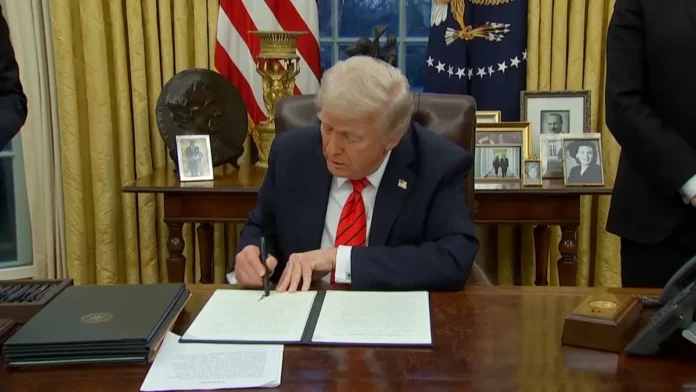
Executive Insights:
- Trump signs executive order targeting disorderly conduct, violent confrontations, and illegal squatting.
- Executive action grants homeowners stronger enforcement tools against illegal squatters.
- Critics in corporate media largely overlook benefits of new policy addressing violent crimes.
By Samuel Lopez – USA Herald
In a decisive move aimed at curbing escalating violence and disorderly behavior on American streets, President Donald Trump signed a robust executive order titled “Ending Crime and Disorder on America’s Streets” on July 24, 2025. Despite heavy criticism from corporate media outlets alleging the order unfairly targets the homeless and mentally ill, crucial elements of the policy beneficial to everyday citizens, homeowners, and rental property managers have largely been overlooked.
The order explicitly addresses rising public safety concerns by emphasizing that disorderly behavior and sudden confrontations often escalate into violent assaults. According to the text of the executive order, such behaviors have become “endemic,” placing both public safety and individual welfare at risk. President Trump states unequivocally, “My Administration will take a new approach focused on protecting public safety.”
Prioritizing Public Safety and Addressing Violent Behavior
At the core of this executive order lies the Administration’s acknowledgment that incidents involving disorderly conduct and impulsive confrontations have surged in recent years. According to the order, “Endemic vagrancy, disorderly behavior, sudden confrontations, and violent attacks have made our cities unsafe.”
Trump’s administration underscores the necessity of treating violent behaviors seriously, regardless of whether the perpetrator is experiencing homelessness, mental illness, or drug addiction.
These concerns resonate deeply with numerous reports previously published by USA Herald, highlighting alarming increases in crimes involving assault and battery. Such incidents often arise from impulsive behaviors driven by uncontrolled emotions or psychosis. This order seeks directly to mitigate these threats, emphasizing immediate actions against aggressive, violent conduct.
New Protections for Homeowners Against Squatting
In a major win for homeowners and rental property managers, Trump’s executive order introduces critical new enforcement measures against illegal urban squatting. Section 3 explicitly directs relevant federal agencies, including the Attorney General and Secretaries of Housing, Health and Human Services, and Transportation, to prioritize grant funding for states and municipalities enforcing “prohibitions on urban squatting” – See Executive Order Sec. 3. (a)(iii).
The need for such action has become increasingly urgent, especially in California, where Governor Gavin Newsom’s administration has been criticized for policies creating loopholes exploited by illegal squatters. Homeowners in California and other affected regions often face significant legal hurdles, enduring protracted and costly litigation to reclaim their properties. In some desperate scenarios, property owners have resorted to hiring “squatter removal teams” who forcibly reclaim their homes.
Trump’s executive order promises substantial relief, clearly stating enforcement agencies should directly target illegal squatting, thereby empowering property owners and managers to reclaim control swiftly and legally.
Corporate Media’s Mischaracterization of the Order
Despite the potential for enhanced public safety and stronger homeowner protections, much of the corporate media coverage has narrowly portrayed the executive order as punitive towards vulnerable groups, particularly individuals experiencing homelessness or mental health crises. This characterization overlooks the broader protective intentions of the order, which specifically aim to safeguard law-abiding citizens from disorderly and violent encounters.
Trump’s policy explicitly acknowledges the complex reality of homelessness, advocating for humane institutional treatment via civil commitments, aiming to address root causes rather than superficial symptoms. “Shifting homeless individuals into long-term institutional settings for humane treatment through the appropriate use of civil commitment will restore public order,” the executive order asserts, dismissing criticisms that the measure lacks compassion.
Trump’s directive aligns with existing legal definitions, reinforcing legal clarity and enforcement capabilities. The new order instructs federal officials to support local jurisdictions through legal guidance, grant allocations, and enhanced enforcement standards that clearly target violent or disorderly behaviors.
Moving Forward
While some stakeholders remain critical, many homeowners, property managers, and community safety advocates welcome these measures. The order promises substantial improvements in safety and property rights enforcement, especially critical in states struggling with squatting crises and urban crime spikes.
🔗 For deeper insights and exclusive reporting follow USA Herald on X @RealUSAHerald
Sources:


